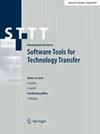通过保持语义的转换来严格理解神经网络
IF 1.4
3区 计算机科学
Q4 COMPUTER SCIENCE, SOFTWARE ENGINEERING
International Journal on Software Tools for Technology Transfer
Pub Date : 2023-05-30
DOI:10.1007/s10009-023-00700-7
引用次数: 5
摘要
在本文中,我们提出了一种精确和全局验证和解释整流神经网络的代数方法,整流神经网络是分段线性神经网络(PLNNs)的一个子类,即语义上表示分段仿射函数的网络。我们方法的关键是这些网络的符号执行,它允许构建语义等效的类型化仿射决策结构(TADS)。由于它们的确定性和顺序性,与决策树类似,TADS可以被视为白盒模型,因此可以作为模型和结果解释问题的精确解决方案。TADS是线性代数,它允许人们优雅地比较整流网络的等效性或相似性,在故障情况下都具有精确的诊断信息,并通过精确地描述特定分类的输入集或两个基于网络的分类器不同的输入集来表征其分类潜力。所有的现象都是通过一个最小的、说明性的例子的详细讨论来说明的:连续异或函数。本文章由计算机程序翻译,如有差异,请以英文原文为准。
Towards rigorous understanding of neural networks via semantics-preserving transformations
Abstract In this paper, we present an algebraic approach to the precise and global verification and explanation of Rectifier Neural Networks , a subclass of Piece-wise Linear Neural Networks (PLNNs), i.e., networks that semantically represent piece-wise affine functions. Key to our approach is the symbolic execution of these networks that allows the construction of semantically equivalent Typed Affine Decision Structures (TADS). Due to their deterministic and sequential nature, TADS can, similarly to decision trees, be considered as white-box models and therefore as precise solutions to the model and outcome explanation problem. TADS are linear algebras, which allows one to elegantly compare Rectifier Networks for equivalence or similarity, both with precise diagnostic information in case of failure, and to characterize their classification potential by precisely characterizing the set of inputs that are specifically classified, or the set of inputs where two network-based classifiers differ. All phenomena are illustrated along a detailed discussion of a minimal, illustrative example: the continuous XOR function.
求助全文
通过发布文献求助,成功后即可免费获取论文全文。
去求助
来源期刊

International Journal on Software Tools for Technology Transfer
Computer Science-Information Systems
CiteScore
4.50
自引率
6.70%
发文量
39
期刊介绍:
The International Journal on Software Tools for Technology Transfer (STTT) provides a forum for the discussion of all aspects of tools supporting the development of computer systems. It offers, above all, a tool-oriented link between academic research and industrial practice.
Tool support for the development of reliable and correct computer-based systems is of growing importance, and a wealth of design methodologies, algorithms, and associated tools have been developed in different areas of computer science. However, each area has its own culture and terminology, preventing researchers from taking advantage of the results obtained by colleagues in other fields. Tool builders are often unaware of the work done by others, and thus unable to apply it. The situation is even more critical when considering the transfer of new technology into industrial practice.
 求助内容:
求助内容: 应助结果提醒方式:
应助结果提醒方式:


